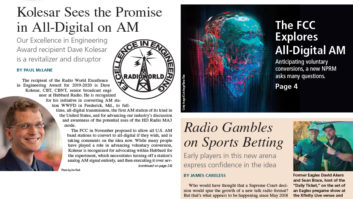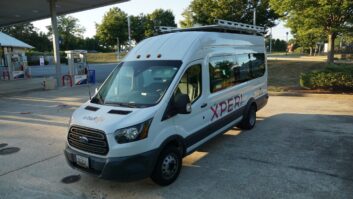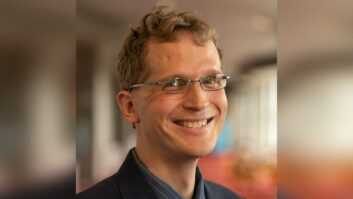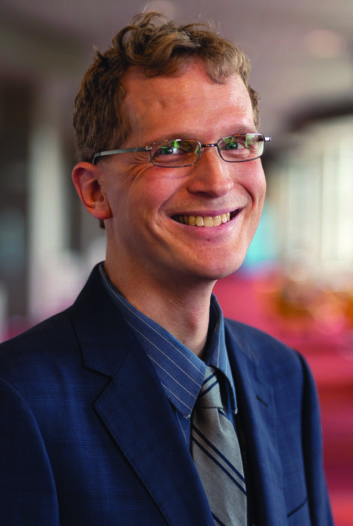
Photo by Jim Peck
The recipient of the Radio World Excellence in Engineering Award for 2019-2020 is Dave Kolesar, CBT, CBNT, senior broadcast engineer at Hubbard Radio. He is recognized for his initiative in converting AM station WWFD in Frederick, Md., to full-time, all-digital transmission, the first AM station of its kind in the United States, and for advancing our industry’s discussion and awareness of the potential uses of the HD Radio MA3 mode.
The FCC in November proposed to allow all U.S. AM band stations to convert to all-digital if they wish, and is taking comments on the idea now. While many people have played a role in advancing voluntary conversion, Kolesar is recognized for advocating within Hubbard for the experiment, which necessitates turning off a station’s analog AM signal entirely, and then executing it over several years. The experiences and findings at WWFD are an explicit part of the FCC’s NPRM text, and its project continues to produce insights that are likely to be of benefit to other broadcasters.
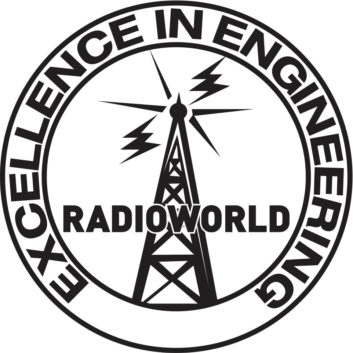 Kolesar is transmitter engineer for WTOP(FM), Federal News Radio as heard on WFED(AM), and WWFD. He also is program director of The Gamut, the format broadcast on WWFD. Prior to Hubbard, he worked as an electronics engineer in the Information Technology Division of the U.S. Naval Research Laboratory. He holds Master of Electrical Engineering and Bachelor of Science in Physics degrees, both from Catholic University.
Kolesar is transmitter engineer for WTOP(FM), Federal News Radio as heard on WFED(AM), and WWFD. He also is program director of The Gamut, the format broadcast on WWFD. Prior to Hubbard, he worked as an electronics engineer in the Information Technology Division of the U.S. Naval Research Laboratory. He holds Master of Electrical Engineering and Bachelor of Science in Physics degrees, both from Catholic University.
We talked with him in late November.
Radio World: What brought you into radio engineering?
Kolesar: It goes all the way back to when I was five or six years old, when my parents bought me one of those Radio Shack AM broadcast station kits. I put it together and it was magic.
I borrowed my older sister’s record player and her stack of 45s, and I would torture my parents playing DJ and making them listen to me on the radio.
Growing up in the D.C. area and listening to some of the big radio personalities in the 1980s, I was inspired by all of this. I ended up teaching myself electronics to build bigger studios and bigger transmitters. By the time I was 13, I put on the air this little radio station out of my bedroom. We’ll call it Part 15 and a half.
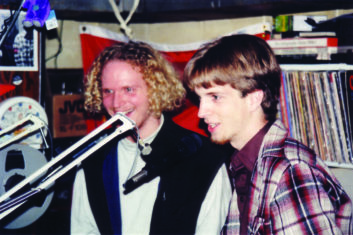
I started a campus radio station in high school. I was the engineer of our college radio station. I went to Catholic University in northeast D.C. I kept my station. In college, I took my little hobby venture online and I kept running that even throughout my career.
I tried to get a real job. I worked for the Naval Research Lab for five years as an electronics engineer after grad school, and I still kept my hobby going online. When a job opening at WTOP appeared, I decided to finally give a shot of unifying my hobby and my career. I started working part-time at WTOP; in 2006 I started working full-time.
Then my career life took another random direction in 2011 when WTOP was sold from Bonneville to Hubbard. The HD3 station on WTOP, which had been, by corporate edict, airing the Mormon Channel, went silent. Joel Oxley, the GM of WTOP, suggested that we put my own internet radio station on the HD3, and that’s how The Gamut was born.
Eventually it got put on 820 [kHz], so having control of that station, it became easy for me to suggest digital on it.
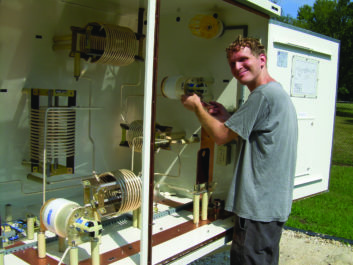
RW: There must have been a day when you said to somebody, “Hey, I’ve got this idea. Let’s turn off the analog and try out all-digital.” Most AM owners aren’t going to jump at that.
Kolesar: What made the conversation easier was the fact that we had gotten an FM translator for the station. I think it was about Christmas-time 2016. I knew the translator was coming. At a lot of other stations, as soon as they get the translator, especially a music station, listenership migrates immediately to the FM translator, making the AM station little more than a legal justification to put this low-power FM signal on the air.
Knowing that this was in the future of that signal, I thought, “Well, what can we do to make this more than just a legal justification? What can we do to actually have the station add value in the quest for listeners? How can you make this valuable?”
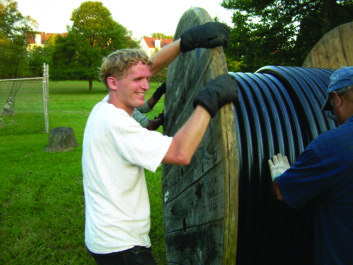
Around 2008 or 2009, I’d heard the MA3 tests that iBiquity was running on 1670 on its experimental station, which was diplexed with WWFD. I was already privy to firsthand knowledge of how MA3 could sound and how robust it was and how well it covered.
The thought occurred to me, well, why don’t we just try that; that way we could use our FM signal and tell people that, “Hey, you know, we’ve got this AM station. When you start to lose reception, flip back to 820 and listen to the station for another 30 or 40 miles while you’re driving.”
And I’ve told people before how I went to the CES in 2017 and approached the Xperi booth.
In order to sell it to management, the process was not as difficult as I’d anticipated, because the FM translator seriously reduced the risk of a digital conversion. Also WWFD is not one of the main signals in the Hubbard D.C. market. It’s up in Frederick; I guess you could say it was never going to be a big moneymaker anyways. It was easier for Hubbard to say, “Let’s take the risk on this smaller asset and see if you can make something of it.” I wasn’t going to convince Hubbard to do it on a 50 kilowatt AM signal first.
I should stress that I’ve been working extensively with Mike Raide at Xperi Corp., who having worked with MA3 himself, didn’t need convincing that this was a great idea. All of these digital AM efforts wouldn’t have happened without him.
RW: Somebody who runs an AM station will want to know how good it can sound.
Kolesar: An honest assessment, it can sound as good as the best FM HD2 signal that you’ve ever heard. The bitrate for the digital signal is about 40 kilobits, and so that’s about equivalent to probably one of the higher-quality HD2 signals. And with proper audio processing, you can make that sound just as good as an analog FM.
It’s got frequency response out to 15 kHz; it’s stereo; you have title, artist and album metadata, as well as images such as station logo and album artwork. So not only do you have aural parity with everything else that you might find in a car dashboard, you have visual parity as well.
RW: The FCC has opened an NPRM now.
Kolesar: I think that it was very wise of the FCC to act quickly on the NPRM. The analog AM audience is not getting any bigger. AM is in a bit of a race against time to reinvent itself before, quite frankly, at least in many areas of the country, it’s forgotten. AM is battling for relevance right now.
Everybody will say content is the problem or content is key, and that’s absolutely true; but the medium itself limits what kind of content can go on it. As a result, AM is at a competitive disadvantage, it’s only conducive to certain types of programming.
All-digital AM erases that disadvantage; any kind of programming that you could put on FM or even a streaming broadcast or a satellite broadcast can be put on an AM station with digital.
RW: Do you see a day when this dramatically revitalizes the band, because suddenly AM stations sound a lot better, and big-market stations would start to consider doing it? The answer clearly involves receiver availability, but is there a big-picture upside, or is this more sort of a holding strategy?
Kolesar: Let me tell you where I think receiver design is going. Most terrestrial broadcasts are listened to in vehicle, so we need to talk about what the car radio of the future is going to look like.
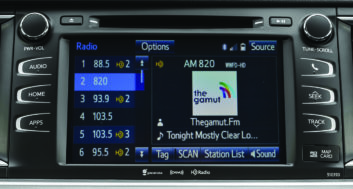
Receiver design is trending towards tuning by visual metadata. You’re going to see receivers that scan the bands and will display the content available in the area as thumbnail icons on a screen. You see the programming that’s available to you, then you’ll see a bunch of station logos. You press the button and you hear programming that is available in your area. Now that programming could be on AM, FM, it could be a satellite program, it could be a stream that you have bookmarked. It won’t necessarily be obvious; it’s just content; but it has to be digital content in order for the receiver to display that metadata.
The way that you’re listening to an audio program in the car won’t necessarily be inherently obvious; it’s just that digital AM is going to be one solution “under the hood,” to get local content to receivers. It puts AM in the ecosystem of digital audio delivery into the dashboard. People aren’t necessarily going to say, “I listen to AM radio,” it’s just yet another way of delivering content.
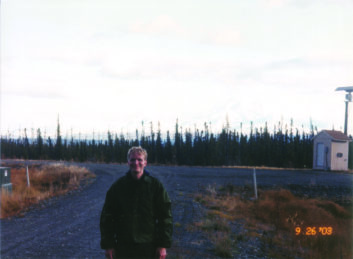
Since we’ve got all of this broadcast infrastructure in the United States already built for medium-wave transmission, this is a great way to bring it up to date and to keep it relevant in the car. That is what I see as the end game. It will probably go that way with or without AM; this is just a way of making sure that AM is part of that solution.
I imagine there’s going to be a number of stations who see a competitive advantage to going digital early on, stations frankly with not as much to lose; and they will build, like WWFD is building, a new audience from scratch. Then as people start listening to those services, the bigger stations will take note. Probably the last stations to convert will be the established legacy stations with significant analog audiences.
Right now about 25% of cars on the road are capable of receiving HD Radio. As the program director of a triple A station on AM, I would rather take my chances with that 25% than with the 100% who could get it but would refuse to because of quality.
RW: What question do you hear the most from industry colleagues?
Kolesar: The biggest concern is receiver penetration right now, because an AM station with a substantial analog audience is going to take a look at the 25% number in the car and say that’s not good enough to switch. If they have an established audience, they may want to wait a few years.
Over half the cars being sold now have HD built into them, and that number is going to continue to go up, so both through attrition and new sales, the percentage of cars with HD Radios are going to increase. For an established analog player, it becomes a waiting game of at what point would you switch over and perhaps even gain a new audience from people who are willing to hear your programming in higher quality.
Receiver penetration numbers are good enough for new players; established players would probably want to wait a little bit.
RW: What would a typical station expect to spend to update their facilities?
Kolesar: There’s two pieces to look at. There’s your antenna system and there are the transmitters. If you’ve maintained your antenna system and you have a new transmitter or one that’s capable of all-digital operation, your costs of going digital could be very minimal. If you have to do a complete site rehabilitation, you might be spending tens of thousands of dollars, and you might be talking about buying a new transmitter. If you’re a 50 kilowatt AM, that’s well over $100,000.
I ask people, “Have you done the hybrid mode of HD in the past? If you have, then your antenna system is already compliant for MA3 operation, so you likely will not have to do anything with your antenna system.” Then I ask what kind of transmitter they have. If you’ve got an old tube rig, you’re going to have to buy a new transmitter. If you have something like a Harris DX series, a Nautel NX series or even an XR series, chances are your transmitter is ready or could be easily modified. It really depends on what kind of shape your antenna system is in and what kind of transmitter you have.
RW: If the FCC acts quickly and makes it optionally available to everybody, how many stations would switch?
Kolesar: I truly do not know. You’ll probably see a number of smaller stations, maybe Class B and C stations with translators, switch relatively quickly.
A number of stations have approached Xperi and me about converting; the stickler is the fact that an experimental is required. Informally we could probably say that the FCC, looking to further the art of AM broadcasting, would be inclined to renew an experimental for MA3 operation; but a station owner may not want to make an investment in something that could be taken away in a year.
RW: Is it going to add a lot of interference on the band and make noise even worse?
Kolesar: I don’t believe so. Remember, these digital stations are living in the analog allocations world. They still have to meet the same emissions mask, they still have to meet the same power levels, they still have to abide by the same protection scheme.
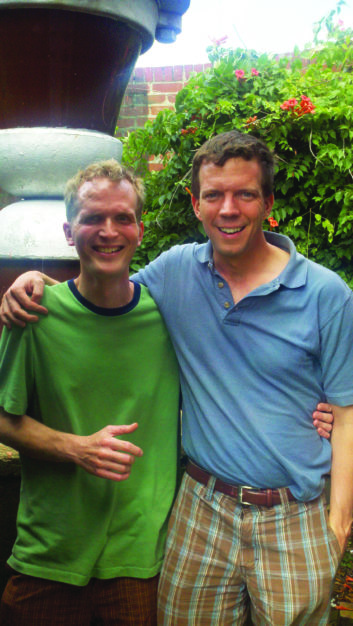
I can just relay my qualitative experiences with WWFD. For instance, in our nighttime interference-free (NIF) contour, when we were analog, you couldn’t listen to adjacent-channel stations, 810 and 830, because of modulation splatter. When we went digital, all of a sudden you can hear 810 and 830 — not perfectly, because you hear the digital hiss underneath these stations, but the digital-to-analog interference, at least to my ear, is more palatable because it just comes across as background static rather than a splatter that would ruin intelligibility. My personal experience has been that digital-to-analog interference is not as severe as analog-to-analog interference.
RW: Closing thoughts?
Kolesar: I think MA1, the hybrid mode of HD Radio, did a disservice to MA3, because MA1 doesn’t work well. At best MA1 is a compromise. It compromises the analog and it certainly compromises the digital. So people have based their perceptions and have hardened their opinions about digital AM based on their experiences with the hybrid mode. In that sense hybrid has done a disservice to the potential of a digital transition for AM.
The MA3 mode of HD Radio is much more robust because all the power goes into the digital carriers rather than the digital carriers being 30 dB down from the analog signal, as it is in the hybrid.
You have better sound quality. Even though the bitrates are somewhat comparable, the sound quality in MA3 in general is so much better because you can process it specifically for a low-bit rate digital stream; in the hybrid mode you have to process the digital signal similar to how you would process an analog AM signal, so that it would be an easy transition on the ear between analog and digital, and as a result the digital didn’t sound nearly as good because a lot of stations processed their digital portion of the hybrid signal too aggressively. The codec didn’t have that many bits to work with, and it ended up sounding muddy, whereas in this case you really can approach FM-like sound quality with the all-digital mode.
In summary, the hybrid mode did a disservice to the all-digital mode. And now there’s a bit of re-education that has to go on in terms of selling people on the notion of digital AM.
Comment on this or any story to [email protected].
Past recipients of the Radio World Excellence in Engineering Award are Andy Andresen, Mike Starling, John Lyons, Clay Freinwald, Jeff Littlejohn, Gary Kline, Milford Smith, Barry Thomas, Paul Brenner, Marty Garrison, Wayne Pecena, David Layer, Mike Cooney, Larry Wilkins and Russ Mundschenk.





